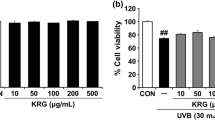Abstract
Trichloroacetic acid (TCA) is one of the most widely used peeling agents, and induces full necrosis of the whole epidermis, followed by reconstitution of the epidermis and the matrix of the papillary dermis. The cytotoxic effects of TCA, such as suppressing proliferation of keratinocytes and fibroblasts and protein synthesis by fibroblasts, have already been reported. However, the entire biological mechanism responsible for TCA peeling has yet to be determined. Hypothetical activation effects of TCA treatment on epidermal cells to induce production of growth factors and cytokines are examined, and are compared with its cytotoxic effects in terms of time course and applied TCA concentrations. After various periods of incubation with TCA, viability of Pam212 murine keratinocytes was investigated with MTT assay and dye exclusion assay, and production of growth factors and cytokines with reverse transcription-polymerase chain reaction (RT-PCR). Changes in platelet-derived growth factor (PDGF)-B mRNA expression and protein production in the human skin specimens after TCA application were then examined by RT-PCR and immunohistochemistry, respectively. Incubation with TCA showed cytotoxicity and induced death of Pam212 cells, depending on the incubation period and the TCA concentration. In addition, expressions of PDGF-B, tumor growth factor (TGF)-α, TGF- β1 and vascular endothelial growth factor, which are the growth factors reportedly secreted from keratinocytes during wound healing, were all detected in Pam212 cells after short-term treatment with TCA. Expressions of inflammatory cytokines such as interleukin (IL)-1 and IL-10 were also induced. In TCA-treated NIH-3T3 fibroblasts, in contrast, observed was upregulation of only keratinocyte growth factor, which is reportedly secreted from fibroblasts, as well as the similar cytotoxic effect. In human skin, PDGF-B mRNA expression became significantly upregulated after TCA application, and then immediately downregulated. Immunoreactive PDGF-B in the cytoplasm of keratinocytes became detectable throughout the epidermis after TCA application, reached maximum after the peak of mRNA expression, and then declined significantly over 24 h when the epidermis became completely necrotic. The TCA-treated epidermis acts as a major source of growth factors, including PDGF-B, before undergoing full necrosis. This effect might contribute to a promotion of re-epithelialization and dermal regeneration without wound contraction and scarring.





Similar content being viewed by others
References
Ansel JC, Tiesman JP, Olerud JE, et al (1993) Human keratinocytes are a major source of cutaneous platelet-derived growth factor. J Clin Invest 92:671–678
Antoniades HN, Galanopoulos T, Neville-Golden J, et al (1991) Injury induces in vivo expression of platelet-derived growth factor (PDGF) and PDGF receptor mRNAs in skin epithelial cells and PDGF mRNA in connective tissue fibroblasts. Proc Natl Acad Sci USA 88:565–569
Brodland DG, Cullimore KC, Roenigk RK (1989) Depths of chemexfoliation induced by various concentrations and applications of trichloroacetic acid in a porcine model. J Dermatol Surg Oncol 15:967–971
Brody HJ (1997) Chemical peeling and resurfacing. Mosby Inc, St Louis
Eming SA, Lee J, Snow RG, et al (1995) Genetically modified human epidermis overexpressing PDGF-A directs the development of a cellular and vascular connective tissue stroma when transplanted to athymic mice: implications for the use of genetically modified keratinocytes to modulate dermal regeneration. J Invest Dermatol 105:756–763
Haisa M, Okochi H, Grotendorst GR (1994) Elevated levels of PDGF α receptors in keloid fibroblasts contribute to an enhanced response to PDGF. J Invest Dermatol 103:560–563
Martin P (1997) Wound healing—aiming for perfect skin regeneration. Science 276:75–81
Rakic L, Lapière CM, Nusgens BV (2000) Comparative caustic and biological activity of trichloroacetic and glycolic acids on keratinocytes and fibroblasts in vitro. Skin Pharmacol Appl Skin Physiol 13:52–59
Robson MC, Phillips LG, Thomason A, et al (1992) Platelet derived growth factor BB for the treatment of chronic pressure ulcers. Lancet 339:23–25
Saba AA, Freedman BM, Graffield JW, et al (2002) Topical platelet-derived growth factor enhances wound closure in the absence of wound contraction: an experimental and clinical study. Ann Plast Surg 49:62–66
Singer AJ, Clark RAF (1999) Cutaneous wound healing. N Engl J Med 341:738–746
Steed DL (1998) Modifying the wound healing response with exogenous growth factors. Clin Plast Surg 25:397–405
Steed DL, The Diabetic Ulcer Study Group (1995) Clinical evaluation of recombinant human platelet-derived growth factor for the treatment of lower extremity diabetic ulcers. J Vasc Surg 21:71–81
Acknowledgments
This study was supported in part by the Japanese Ministry of Education, Science, Culture, Technology and Sports, and the Segawa.
Author information
Authors and Affiliations
Corresponding author
Rights and permissions
About this article
Cite this article
Yonei, N., Kanazawa, N., Ohtani, T. et al. Induction of PDGF-B in TCA-treated epidermal keratinocytes. Arch Dermatol Res 299, 433–440 (2007). https://doi.org/10.1007/s00403-007-0781-6
Received:
Revised:
Accepted:
Published:
Issue Date:
DOI: https://doi.org/10.1007/s00403-007-0781-6




